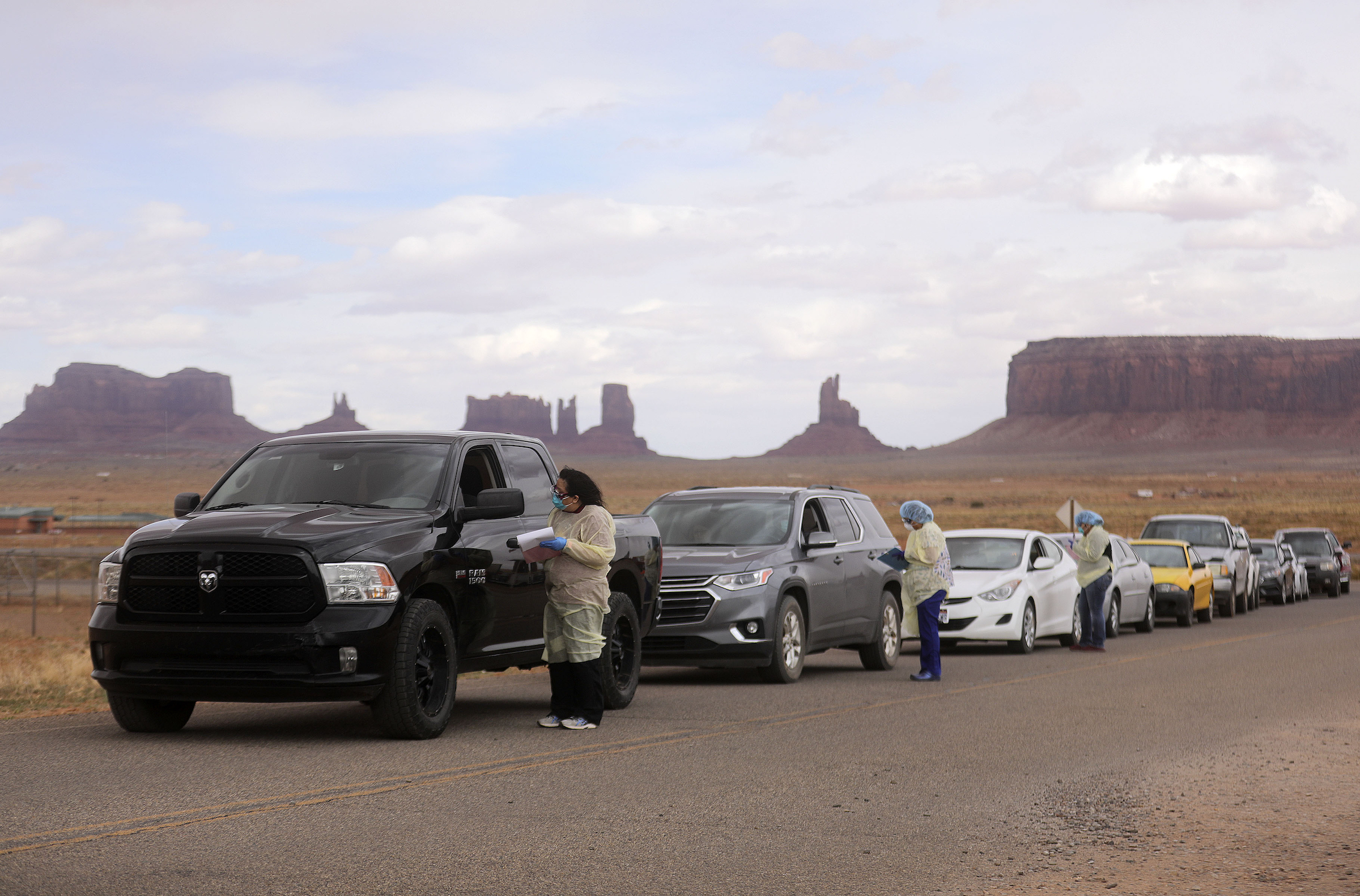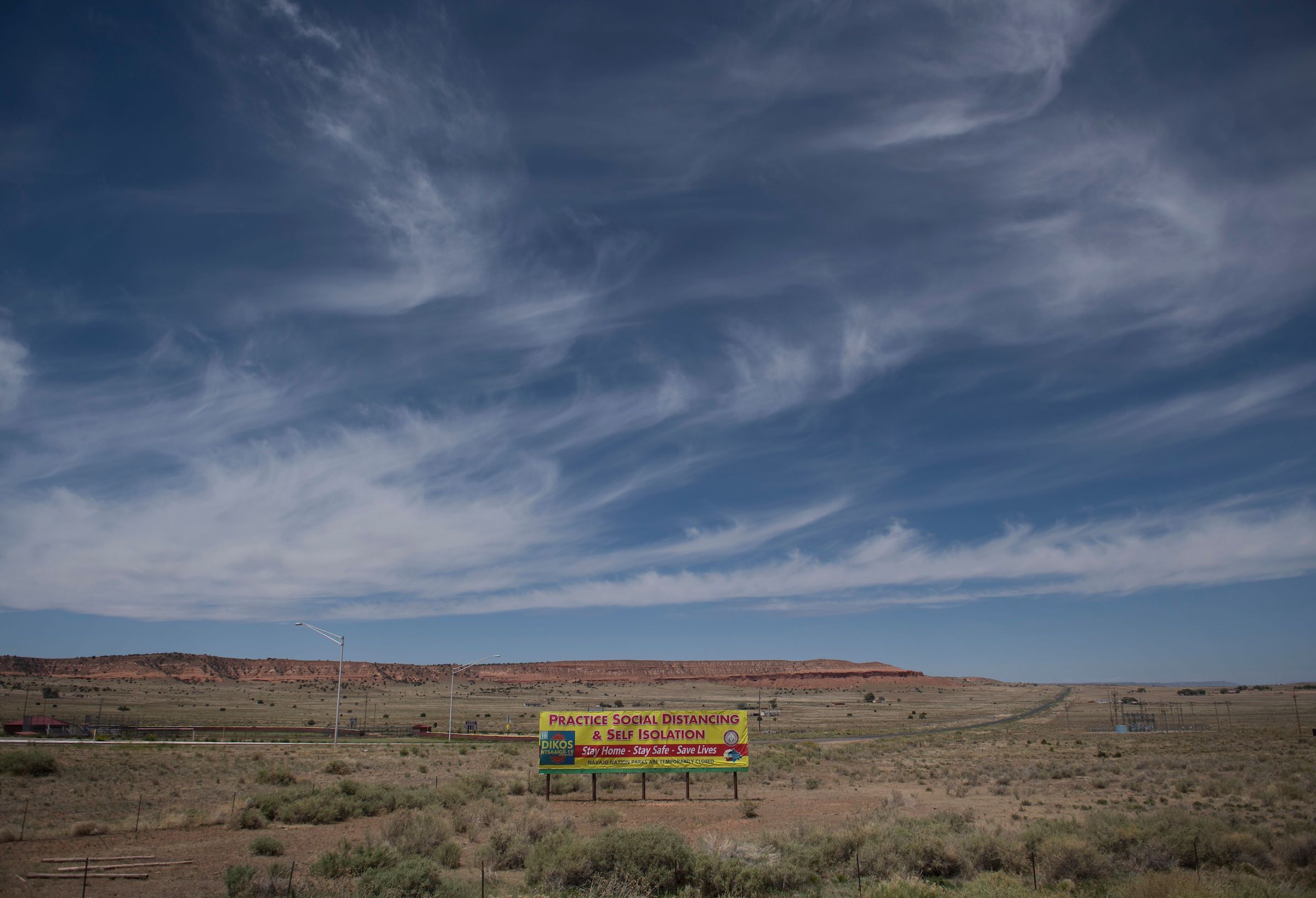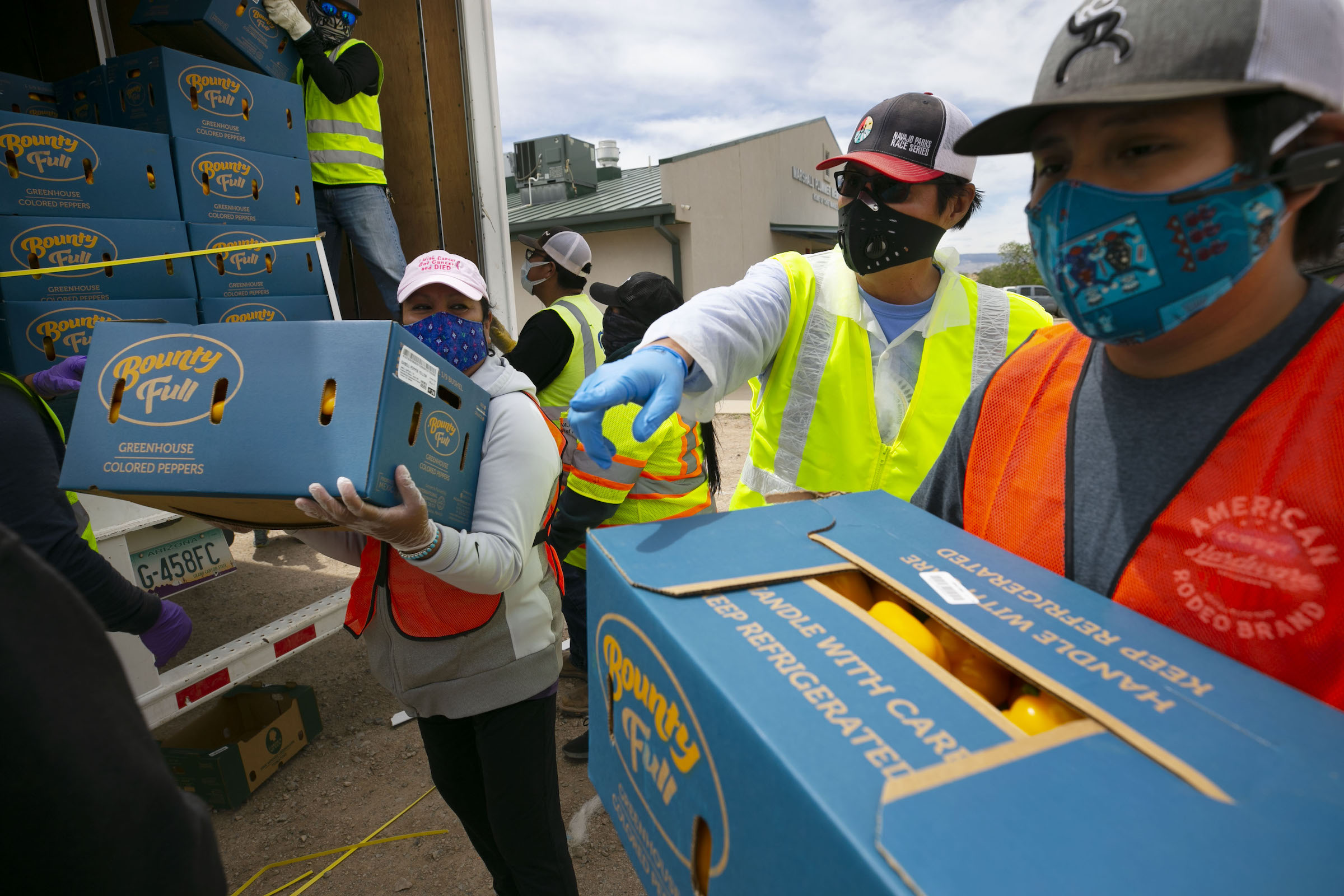
When Eric Freeland, 34, started coughing at the end of March, he didn’t think much of it. But when his symptoms grew worse, Freeland’s mother began to worry. Freeland is a Native American living with his family in the Navajo Nation in the southwestern U.S., where access to healthcare is limited. He is also diabetic, putting him at greater risk to the coronavirus.
When Freeland’s breathing became short and stuttered, his mother drove him to the nearest hospital where within minutes of arriving, he lost consciousness. He awoke three weeks later, hooked up to a ventilator, from a medically induced coma.
“We’ve had epidemics before. We’ve had viruses before. In general, we’ve had a lot of things attack us before,” says Freeland, who has since recovered fully. But this is “the worst case scenario.”
The Navajo Nation, home to more than 173,000 people and spans across parts of Utah, New Mexico and Arizona, has been hard hit by COVID-19, with 4,944 confirmed COVID-19 infections in the community and 159 deaths as of May 29. Before the pandemic, the nation already faced a host of challenges, with up to 40% of people not having access to running water in their homes and 10% not having access to electricity. But despite the outbreak, the Navajo Nation has received little support from the federal government. “The efforts for battling COVID-19 were solely the Navajo Nation’s doing,” says Jonathan Nez, the President of the Navajo Nation. “There was little federal assistance when we were going through the peak of the crisis.”
The Navajo Nation is not alone. While Indigenous communities and cultures vary greatly in the United States, Canada, Australia, and New Zealand, they face similar challenges when it comes to health problems and accessing medical care. The close to 10 million Indigenous people in these four countries who are descendants from the original inhabitants of their countries, have higher rates of chronic health issues making them more susceptible to severe COVID-19 cases.
And yet, they say, federal funding to these communities continues to be insufficient. The COVID-19 stimulus law passed by the U.S. Congress mandates $8 billion for relief to Native American communities, but they had to sue the Treasury Department to access the funds. The support only began reaching the Navajo Nation in mid-May, long after the outbreak had started. Delays in distributing funding left frontline workers without proper protection and forced the Urban Indian Organization to close some of its health facilities due to a shortage of critical resources.
In Canada, where the government pledged to spend $216 million to protect Indigenous Canadians (who make up 4.9% of the population), experts pointed out it would only amount to only around $142 per person. The funding also does not go to Indigenous people living outside of Indigenous reserves, who make up over half of Canada’s Indigenous population. This prompted the Congress of Aboriginal People in Canada to file a federal court application on May 13, alleging that the government’s COVID-19 assistance is “inadequate and discriminatory.” (Prime Minister Justin Trudeau has since announced $54 million to support off-reserve Indigenous people.)
Despite the lack of government support and limited resources, Indigenous communities are implementing public health measures to effectively curb the spread of the virus within their communities. Although the Navajo Nation has one of the highest infection rates per capita in the United States, surpassing New York and New Jersey, the community is testing far above the national average of 4.9%, with 15.64% of its population having been tested. “We are using our own sovereign ability to govern ourselves,” says President Nez. The community also implemented some of the strictest lockdown measures in the country after an outbreak began in their community, mandating that no one leaves home unless they are essential workers or there is an emergency. They say that has helped curb the spread of the virus. “The reason the Navajo Nation has managed this crisis isn’t because of the federal government,” President Nez says. “It’s because of us.”

Indigenous communities have long received worse care during pandemics and witnessed higher mortality rates than the rest of the population. The New Zealand Māori mortality rate during the 1918 Spanish flu was 7.3 times higher than the non-Indigenous mortality rate. During the H1N1 Swine Flu outbreak in 2009, Indigenous Canadians accounted for 17.6% of deaths even though they account for only 4.3% of the country’s population.
“Historically, we have not been treated well when it comes to pandemics,” says Chief David Monias of the Pimicikamak Cree Nation in northern Manitoba. “While the rest of Canada received services [during previous pandemics], we were just left to die.”
The lack of federal support for Indigenous communities is particularly dangerous, given that these communities—who face higher rates of chronic illnesses—are more vulnerable to COVID-19.
In Australia, 50% of Aboriginal people live with one major chronic disease such as cancer, cardiovascular or kidney disease and nearly 25% have two or more chronic ailments. “If you look at Indigenous Australians, they have onset of kidney and cardiovascular disease earlier than non-Indigenous Australians,” says Jason Agost, an epidemiologist focussed on Aboriginal and Torres Strait Islander health. In Canada, First Nations, Inuit and Métis communities have a lower life expectancy than the national average and in the United States, the mortality rates for preventable diseases such as asthma or diabetes are three to five times higher for Native Americans.
While experts say there is no single reason for why Indigenous populations face poorer health outcomes, Stephane McLachlan, a researcher looking into effective responses to COVID-19 for Indigenous populations says it can be explained by “the long standing impacts of colonization” which have left Indigenous people poorer on average and lacking access to nutritious food, clean water and adequate housing.
As well as higher rates of chronic illnesses that make them more vulnerable to the coronavirus, Indigenous communities often cannot implement precautionary measures to stop the virus spreading rapidly.
In Canada, at least 61 First Nations communities have not had access to safe drinking water for at least a year. While some non potable water sources can be effective for washing hands, the Canadian government says that communities on a “Do Not Use Advisory” should not use tap water for washing hands. “The government keeps telling people to wash their hands,” Meredith Raimondi, a senior manager from the United States National Council of Urban Indian Health. “But how are Indigenous people supposed to do that when they don’t have clean water?”
For many Indigenous people living in overcrowded homes, social distancing or isolation is also impossible. Aboriginal and Torres Strait Islanders are 16 times more likely to be living in an overcrowded house than non-Indigenous Australians.
This was the case for Freeland, who like many Native Americans, lives with his extended family. Both his parents fell ill with the virus after he contracted it. “So many of us live in close quarters,” he says. “By the time my symptoms started to show, it was too late.”
Keep up to date with our daily coronavirus newsletter by clicking here.
Indigenous people also disproportionately struggle to access medical services if they do fall ill with COVID-19. Some Indigenous communities live in remote areas where governments have not invested in health infrastructure, resulting in people having to travel hundreds of miles to reach the nearest medical facility. In Northern Canada, many communities cannot be accessed by road and require planes or boats. Some remote communities in Australia only have a single nurse present on the ground, with doctors consulting patients over the phone.
“So many Native Americans have to drive for hours to see a doctor or get to a grocery store,” Freeland says, noting that he is lucky he lives within close proximity to hospital facilities. “I wouldn’t have made it if, like other Native Americans, I had been a little further away.”

For all the challenges Indigenous communities face—from a lack of federal funding to higher rates of pre-existing comorbidities that increase vulnerability to COVID-19—these communities have taken matters into their own hands. They say Indigenous led-responses are the key to mitigating the impacts of the virus.
“Money is a good start but it’s not the whole story,” says Shannon MacDonald, a Canadian Indigenous physician and deputy chief medical officer for First Nations Health Authority, a health service delivery organization in British Columbia. “It’s about communities having the ability to respond within the communities.”
Because Indigenous people often face systemic racism when seeking out medical attention, MacDonald says that “some of our community members are reluctant to access services unless it’s absolutely necessary.” Indigenous health providers, who understand Indigenous cultures, have proven to be better equipped to develop culturally-sensitive public health responses for these communities.
Indigenous-led responses have already proven to be successful, and in some cases, more effective than federal responses.
The Lummi Nation, a sovereign Native American community in the Pacific North-West have been preparing for COVID-19 since the virus appeared in China, gathering additional medical supplies including test kits and creating the country’s first field hospital. The Nation declared a state of emergency on March 3, 10 days before the Trump Administration did and has implemented health measures including social distancing, drive-through testing, essential good deliveries for the elderly and phone call consultation with doctors. The Lummi reservation, home to 5,583 people, has had 40 cases as of May 2—an infection rate in line with the national average.
In Australia, Aboriginal communities have been less affected by the virus than anticipated, which experts attribute to having Aboriginal and Torres Strait Islander public health practitioners and researchers play a pivotal role in leading response efforts that are culturally sensitive. Aboriginal-led health services ensured that public health messages were communicated to communities in their local languages. Aboriginal communities also protected themselves by camping out in the bush to protect elders. Like many Indigenous Nations in Canada, some Australian Aboriginal communities also shut their borders before the federal government did to avoid disease transmission.
“We can’t be waiting for the government to decide,” says Myrle Ballard, a Canadian Indigenous researcher studying effective health responses to COVID-19 for Indigenous communities. “We Indigenous people know what is best for us.”
Please send any tips, leads, and stories to virus@time.com
More Must-Reads From TIME
- The 100 Most Influential People of 2024
- The Revolution of Yulia Navalnaya
- 6 Compliments That Land Every Time
- What's the Deal With the Bitcoin Halving?
- If You're Dating Right Now , You're Brave: Column
- The AI That Could Heal a Divided Internet
- Fallout Is a Brilliant Model for the Future of Video Game Adaptations
- Want Weekly Recs on What to Watch, Read, and More? Sign Up for Worth Your Time
Contact us at letters@time.com